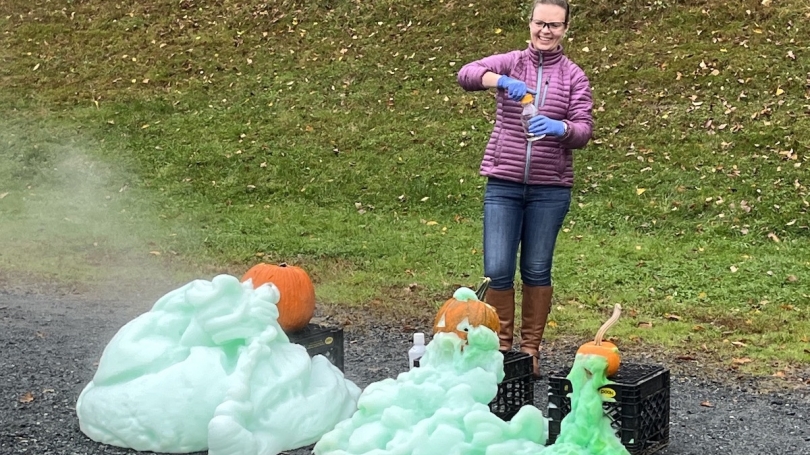

From liquid nitrogen ice cream to pumpkin-themed thermodynamics demonstrations, the Department of Chemistry pulled out all the stops to showcase the beauty, joy, and utility of chemistry in everyday life.
Students, faculty, and staff walking through the Burke Laboratory lobby this week got a chance to taste ice cream made from liquid nitrogen, learn about the science of slime, and separate dyes using different fabrics.
At the same time, participants networked with peers, learned about how to get involved in chemistry research at Dartmouth, and discovered how to find related resources and services through the Dartmouth Library.
These activities and many more—all led by graduate students, postdocs, research staff, and faculty—were part of Dartmouth's celebration of National Chemistry Week, a public awareness campaign initiated by the American Chemical Society that showcases the importance of chemistry.
"National Chemistry Week is an excellent opportunity to draw attention to the beauty, joy, and utility of chemistry in our everyday life," says chemistry professor and department chair Ivan Aprahamian. "I hope that students enjoyed learning about the chemical processes that touch our lives, from the food we eat to the clothes we wear."
A Partnership With Dartmouth Library
When librarian Lilly Linden realized that the theme of this year's National Chemistry Week connected closely with research being done at several labs at Dartmouth, she was keen to mobilize the entire Dartmouth chemistry community to participate.
"The theme of 'fabulous fibers' and the chemistry of fabrics ties in with research in our labs and also with a new plant dye garden project," Linden says.
For example, members of the Sandford Lab shared several swatches of different fabrics to demonstrate how they separate commercially available dyes in comparison to standard chromatography paper. Graduate students from the Mirica Lab demonstrated applications for metal-organic frameworks on textiles. And members of the Zhang Research Lab presented a computational simulation of a single nylon fiber strand.
A collaboration between the Dartmouth Organic Farm and the Library's Book Arts Workshop, a new plant dye garden project harnesses natural dyes for paper and cloth. On Thursday night, a hands-on demonstration gave students the chance to create dyes from plant materials, apply them to paper and cloth, and discuss techniques for adjusting hue.
thumbnail_img_447319.jpg

"I hope our undergrads were able to feel the excitement that drives research in the Chemistry Department at Dartmouth," Linden says. "I'm so proud of the way in which the entire Chemistry Department—faculty, postdocs, research staff, graduate students, and administrative staff—worked collaboratively with me to put together these outreach opportunities during the busiest term of the year."
Chemistry in the Community
On Tuesday, Wendy Epps, a senior lecturer in chemistry, and Associate Professor of Chemistry Katherine Mirica visited the nearby Ray School in Hanover to lead pumpkin-themed chemistry demonstrations with over 80 fourth-grade students.

Epps and Mirica introduced the concepts of physical change, catalysis, and thermodynamics by smashing frozen pumpkins and pouring molten iron through pumpkins, creating a "puking" effect.
"The fourth graders were very engaged and had many questions," Epps says. "They seemed to enjoy connecting what they were observing in our demonstrations with things that they have observed in other parts of their lives. I hope that they took away the idea that chemistry is relevant and fun!"